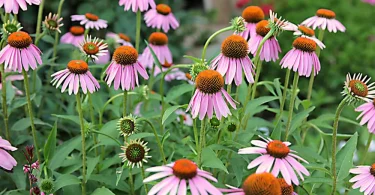Queen Anne’s lace (Daucus carota) vs poison hemlock (Conium maculatum) are two plants that are often confused due to their similar appearance but having distinct characteristics. However, due to the extreme toxicity of poison hemlock, this plant is considered one of the most toxic in North America and poses a significant danger to living organisms. On contrary, Queen Anne’s lace is non-toxic. However, this blog demonstrates the notable difference between Queen Annes lace and poison hemlock.

General Botanical Information to identify Queen Annes Lace and Poison Hemlock
You can use general botanical information to accurately identify Queen Anne’s lace (Daucus carota) and poison hemlock (Conium maculatum). However, here are some critical differences between Queen Anne’s lace and poison hemlock:
| Characteristic | Queen Anne’s Lace | Poison Hemlock |
| Family & Genus | Apiaceae family, Daucus genus | Apiaceae family, Conium genus |
| Botanical names | Daucus carota | Conium maculatum |
| Pronunciation | DAW-kus kuh-ROH-tuh | KOH-nee-um mak-yuh-LAY-tum |
| Growth Form | 4 feet tall with upright stems, umbrella-shaped clusters of tiny white flowers (umbels) | small erect clusters of height of 10 feet. |
| Leaves | Finely divided, feathery, lacy, or fern-like appearance, narrow segments | Finely divided, fern-like, larger and coarser than Queen Anne’s lace |
| Stem | Covered in fine hairs, slightly rough to the touch | Smooth, hairless, often with purple blotches or streaks |
| Flower Cluster (Umbel) | Central floret is purple or dark red | Lacks a purple or red central floret, all flowers in the umbel are white |
| Habitat & Location | Found in various habitats, including fields, roadsides, disturbed areas | Prefers damp, marshy areas, less common in dry upland habitats |
| Toxicity | Non-toxic, related to cultivated carrot | Highly toxic to humans and animals |
Year-Round Radiance of Queen Annes Lace vs. Poison Hemlock Plant Care Calendar
Queen Anne’s lace (Daucus carota) and poison hemlock (Conium maculatum) have different growth habits and life cycles. However, Queen Anne’s Lace is a biennial plant, while poison hemlock is a biennial to short-lived perennial. Here’s a year-round care calendar for these two plants:
| Month | Queen Anne’s Lace | Poison Hemlock |
| Spring | – Sow seeds directly in early spring in well-draining soil. – Water newly planted seeds regularly. – However, it prefers full daylight for optimal growth. | – Identify and control poison hemlock due to its toxicity. – No watering required; focus on control. – Tolerant of various light conditions. |
| Summer | – If necessary, supplement watering. tolerates partial shade. | – In the summer, continue monitoring poison hemlock. – Uproot or cut the plants. – No watering required. – Tolerant of various light conditions. |
| Fall | – This season is called dormancy for biennial plants, which are in the process of setting seeds and preparing for dormancy. – No specific watering care. – Thrives in full sun. | – If poison hemlock is still growing, remove it. – Cut the plants. – No watering required; continue control. – Tolerant of various light conditions. |
| Winter | – Queen Anne’s lace enters dormancy, minimal care is required. – No watering required; continue monitoring. – Tolerates various light conditions. | – Continue monitoring for any remaining plants. – No watering required; continue monitoring. – Tolerant of various light conditions. |
Note:
Queen Anne’s lace can be cultivated or managed in gardens, poison hemlock should be strictly controlled due to its extreme toxicity.
Read: Daucus Carota (Queen Anne’s lace) types, propagation, and problems
Identification of queen annes lace vs. poison hemlock
Queen Anne’s lace[1]Identification of Queen Anne’s lace. Read features finely divided, feathery leaves with a lacy appearance and a mild, carrot–like scent when crushed. Its stems are covered in fine hairs, and the central floret in its flower cluster is purple or dark red. Therefore, this plant is non-toxic and found in various habitats.
On the other hand, poison hemlock has more prominent, coarser, fern-like leaves with a disagreeable, musty odor when crushed. Moreover, its stems are typically smooth, with purple blotches, and its flower cluster lacks the purple or red central floret. However, Poison Hemlock has a toxic nature and thrives in damp, marshy areas[2]Identification of Poison Hemlock. Read.
Identification of Queen Anne’s Lace (Daucus carota): Key Features
| Characteristic | Description |
| Biennial Herb | Grows as an erect, herbaceous biennial plant in the carrot family (Apiaceae), reaching 2-4 feet[3]Queen Anne’s Lace Botanical Information. Read. |
| Stems | Erect, hairy, hollow stems, often with a reddish tint at the base. |
| Leaves | Basal, alternate, pinnately compound with finely divided, fernlike leaflets. |
| Flowers | Small, 5-petaled white flowers arranged in a terminal, umbrella-shaped cluster. |
| Roots | Long, slender white taproot and fibrous secondary roots, potentially woody with a carrot–like odor. |
| Reproduction | Reproduce or propagate by seed. |

Identifying Characteristics: Poison Hemlock (Conium maculatum)
| Characteristic | Description |
| Stout, Branched Stem | Robust, extensively branched, and ridged stem. |
| Distinct Mottling | Lower stem portions display distinct purple spots. |
| Leaf Description | Shiny green, triangular leaves, highly dissected, arranged alternately, decreasing in size upward. |
| Leaflet Arrangement | Leaves are pinnately compound, consisting of pairs of small, segmented leaflets. |
| Flowering Period | Flowers appear in July and August, forming broad compound umbels. |
| Seed reproduction and Seed Longevity | Reproduced solely by seeds and have a relatively short life span of three years. |

Leaf Appearance of queen annes lace vs. Poison hemlock
The leaves of Queen Anne’s lace (Daucus carota) and poison hemlock (Conium maculatum) do share some similarities due to their belonging to the same carrot family (Apiaceae). However, there are distinctive differences that can help you tell them apart:
Queen Anne’s Lace Leaves:
- Queen Anne’s lace typically has leaves with fine hairs or bristles similar to those on its stems.
- When touched, these hairs can give the leaves and stems a slightly rough or textured appearance.
- Queen Anne’s lace leaves are finely divided and have a lacy or fern-like appearance.
- They are typically profoundly lobed and pinnately compound, meaning they have many narrow leaflets arranged along a central stem.
- The leaflets are usually feathery narrow, and have a delicate, lacy texture.
- They may appear similar to the leaves of domesticated carrots, which is no surprise since Queen Anne’s lace is a wild relative of the cultivated carrot.

Poison Hemlock Leaves:
- In contrast, poison hemlock leaves and stems are usually smooth and hairless.
- The absence of hairs on poison hemlock is one of the distinguishing features that can help identify it.
- The leaves of poison hemlock are also finely divided and have a lacy or fern-like appearance[4]Detailed Botanical Information of Poison Hemlock. Read.
- They tend to be larger and more robust than Queen Anne’s lace leaves. However, the leaflets can be broader and more substantial.
- Poison hemlock leaves may have a coarser texture than Queen Anne’s lace’s delicate, fine leaflets.
- One distinctive feature is that poison hemlock leaves are often waxy and shiny.

However, both plants have similar leaf shapes and growth forms, the differences in leaf size, texture, and the presence of a waxy shine and hair can help you distinguish between Queen Anne’s lace and poison hemlock leaves.
However, remember that the most reliable identification method is to consider all the plant’s characteristics, including its stem, flowers, odor, habitat, and location, to avoid any potential confusion, especially given the extreme toxicity of poison hemlock.
Toxicity in queen annes lace vs. poison hemlock
Queen Anne’s Lace (Daucus carota) has toxic look-alike relatives, notably poison hemlock (Conium maculatum). However, distinguishing them is crucial for safety. On contrary, Queen Anne’s Lace has a pleasant carroty smell and hairy stems.
Poison hemlock, with a disagreeable odor, features smooth stems bearing purple spots. Poison hemlock is one of the most poisonous plants. However, proper identification is essential due to their varying toxicity levels. Here’s a comparison of the critical chemical compounds found in these plants:
Queen Anne’s Lace Plant Toxicity:
Daucus carota is edible and non-toxic, with various plant parts used for herbal purposes.
- The seeds of Queen Anne’s lace, often collected in the fall, are edible and can be used to make tea.
- The roots of Queen Anne’s lace are edible.
- Queen Anne’s lace’s young leaves can be edible and become increasingly bitter as the plant matures.
Queen Anne’s lace is non-toxic and safe for human consumption. However, the primary chemical of interest in Queen Anne’s lace is beta-carotene, which is responsible for the orange color of carrots.
Poison Hemlock Plant Toxicity:
Poison hemlock, as the name tagged, is a hazardous plant. However, all plant parts contain poisonous alkaloids, including the seeds, roots, stems, and leaves. Moreover, the plant’s toxicity increases as it matures, and even environmental factors like soil moisture, type, temperature, and the season of growth can influence its toxic potency.
If ingested, poison hemlock toxicity presents a severe danger to both humans and animals. Therefore, ingestion of any plant’s part can lead to rapid onset of symptoms including nervousness, muscular weakness, and respiratory paralysis, often resulting in death.
Proper Management Requirements of queen annes lace vs. poison hemlock
Proper management of Queen Anne’s lace (Daucus carota) and poison hemlock (Conium maculatum) differs significantly due to their distinct characteristics and potential risks associated with poison hemlocks’ extreme toxicity. However, here are the management requirements for each plant:
Queen Anne’s Lace
Control and Management:
- Queen Anne’s lace management centers on preventing seed production due to its biennial life cycle. Meanwhile, removal of flowering stalks is essential to stop seed dispersal. Organic methods include timed mowing, hand-pulling, and cutting roots.[5]Control Queen Annes Lace. Read
Poison Hemlock
Control:
- To conquer Poison Hemlock, employ a multi-pronged strategy: timed mowing, plowing, and fostering competitive plants.[6]Poison Hemlock Control and Eradication. Read
Prevent Seed Formation:
- Prevent poison hemlock from producing seeds by removing flowering plants before seed development. However, this helps reduce its ability to spread.
- Proper disposal prevents seed spread.
Conclusion
The context of this blog is distinguishing between Queen Anne’s lace (Daucus carota) and poison hemlock (Conium maculatum), two plants in the Apiaceae family with almost similar growth forms. While they share characteristics like umbrella-shaped clusters of tiny white flowers, they differ in several key aspects. Because poison hemlock is highly toxic, this blog is a helpful guide for safe and accurate identification.



